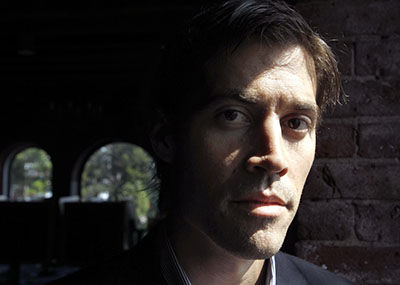Amid the tributes and war stories that followed the brutal beheading of James Foley this week, one memory from a fellow hostage shone a light on a side of his character that his audience might not have seen: his empathy not only for the people he covered but also for the journalists he encountered.
Frenchman Nicolas Hénin spent seven months in the same room with the U.S. reporter and even recognized the shoes he wore in the execution video as a pair they had shared. Hénin was asked by L’Express if Foley had talked about what he wanted to do when he was released.
“Oh, yes,” Hénin replied. “He wanted two things; either to work for the Committee to Protect Journalists or work on interfaith dialogue and rebuild bridges between the Christian and Muslim worlds.”
Foley would have done well in either venture. He was already well known to CPJ staff, who along with many other groups and individuals had advocated for his release when he was captured by pro-Qadaffi forces in Libya in 2011 and held for six weeks.
Foley had been with three other journalists when they came under fire near Brega. One, Anton Hammerl, a freelance South African photographer, was killed.
Captivity in Libya, and the death of a colleague who was working on a shoestring budget, seem to have intensified Foley’s passion to help fellow journalists, particularly those risking their lives in conflict zones without the training, equipment, and finances afforded by major news organizations.
In addition to the normal band of war-hardened reporters, the Libya conflict attracted many less experienced freelancers and newcomers. Journalists had to help one another. Even so, some were unlucky. Acclaimed freelance photographer Tim Hetherington bled to death after taking shrapnel in the leg in Misrata; none of his colleagues knew how to save him. This prompted his friend Sebastian Junger to set up an organization to teach reporters basic first aid–Reporters Instructed in Saving Colleagues, or RISC.
James Foley attended the first-ever RISC course at the Bronx Documentary Center in April 2012. During that course, we sponsored the screening of a film titled “Bearing Witness” about five intrepid women journalists, including another victim of the Syrian war, Marie Colvin. When we spoke after the screening I wanted to hear about his experience, but Foley would have none of it. He wanted to talk about raising money for Anton Hammerl’s family. And he did more than talk.
With great energy, he helped mobilize photographers to donate pictures, which were auctioned the following month at Christie’s in New York, raising $135,000 for Hammerl’s three children. (A slideshow narrated by Foley about Hammerl and the auction can be found here).
Foley said he kept returning to the frontlines to follow Colvin’s exhortation to bear witness, but he went beyond observing. He helped. After documenting the toll taken on civilians, particularly children, by the fighting in Aleppo in a piece for GlobalPost, Foley launched a campaign to raise money for the hospital he had filmed.
After his November 2012 capture in Syria was eventually made public, we joined with colleagues, including his friend Nicole Tung, to try to secure his release. James Foley must have known that all those who loved him, his friends, and his colleagues were doing all they could. I wish James Foley had realized the ambition he imparted to Nicolas Hénin. He would have made a great press freedom fighter.
